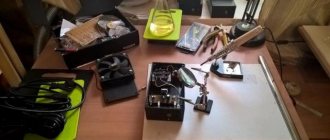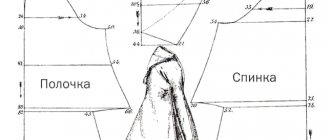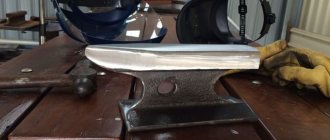Bamboo (wooden) panflute
Making a panflute is quite complicated, but don't let that scare you away.
We will help you with this with our advice. The first problem you immediately encounter is the material. Exclusive tools are made from bamboo and are very expensive because the bamboo is of high quality. It is extremely difficult to choose bamboo tubes that taper evenly and are absolutely round. It’s easier in this regard with wood—it just needs to be properly processed. As for plastic, an unpleasant problem arises here - pipes of only a strictly defined diameter are offered for sale. Ideally, each panflute tube should be individual in size - this is the uniqueness of this instrument.
Here are some tips for making wooden panflutes:
- It is very important to produce tubes that are matched to the maximum possible in terms of internal and external diameters. This is what determines the smooth change in the timbre of sounds from low to high notes without sensitive changes. For this reason, we believe that wood is significantly preferable to bamboo. The main thing is to set up the machine correctly and without much difficulty you will get the necessary tubes. Disadvantages can always be compensated for by treating the inside of the tube with abrasive materials.
- The next tip concerns the inner surface of the tubes themselves. Your task during manufacturing is to achieve the most smooth and cylindrical surface possible. This will give easy sound production and, as a result, a smooth melody.
- It is necessary to pay special attention to the inner surface of the panflute. In this case we are not talking about the tubes, but about the entire instrument. The inside of the tool must be carefully shaped. To check the correctness of this point, you can do the following experiment. Place the panflute on a sheet curved to the shape of its inner side. There should be no gaps left between the sheet and each tube, otherwise the lips, when moving along the instrument, will “cling” to the tubes protruding from the row and, of course, music will not work. The ideal shape for a panflute is an arc. To achieve this shape, the tubes should be laid out on a pre-formed bed, that is, on a curved sheet. Then it will be easy to achieve the desired effect.
- It is important to properly fasten the tubes together. To do this, you need to cut off two pieces of the wall from the tube, that is, to form the surfaces that will glue the tubes together. It is necessary to balance the ratio of the cutting angles. Ideally, they are radii drawn from the center of the circle, which is the inner surface of the panflute. If it is not possible to evaluate and carry out such cuts so accurately, then you have to vary the offsets, which negatively affects the entire instrument. It's better to avoid this. You can also take the advice of professionals and make a cut on only one tube. The cutout surface must be cylindrical. Thanks to this trick, you can avoid the hassle of timing the cuts on the sides of each tube and focus all your attention on achieving the correct inner surface.
- It is better to give priority to thick-walled tubes, as the sound in this case sounds much better.
- The use of glue only at first glance seems to be an insignificant factor. Actually this is not true. Use a strong, fast-curing adhesive as the adhesive becomes part of the resonating instrument. Do not use toxic glue, it can cause poisoning because it comes into contact with your lips.
- Use non-moving plugs, even when making professional tools without a “shoe.” Rubber plugs, although more common, have a tendency to become dislodged over time. You need to drive the plugs so that the sound without using wax is half a tone lower than the desired note. If you are making moving plugs, any rubber material will do.
- If you are making a panflute from a light wood species, such as acacia or cherry, do not apply a thick layer of varnish. The sound will suffer as a result.
Materials and tools for making pipes
To make a wooden pipe with your own hands, we will need a rather impressive arsenal:
- sandpaper
- small wooden sleeve (diameter 1.5 cm and length 4 cm)
- ruler
- pencil
- tuner
- small vise (not necessary, but much more convenient with them)
- something that can be drilled with (drill, drill, engraver) and drills of different diameters: from approximately 0.8 to 4.2 mm
- needle file
- knife
- semicircular incisor
- pair of clamps
- PVA glue
- two wooden blocks 30x2x1 cm.
Clay panflute
If desired, you can make a panflute from clay. Let us present to your attention several options for making the tool:
- A flute is made from a piece of thick clay. Then, using a stick, holes are made in it. This method is simple, but is only suitable for very small and “tall” instruments.
- First, a set of sticks is made. They must match the shape of the inner surfaces of the channels in the panflute. These sticks are most often made from wax. Then the sticks are secured by the tips that are not covered with wax. Next, this structure is covered with clay, that is, the panflute itself is made around the holes already assembled together. When fired, the wax melts and flows out of the clay.
- We wrap a steep clay batch around a separate stick. Then we press the clay-wrapped tubes against each other and fire them. It turns out to be a flute.
- Prepare very liquid clay. Individual sticks are made, then these tubes are dipped into clay. You need to dip it several times. As a result, layer by layer, the required thickness is gained and the panflute is ready.
Here are the basic methods of making a panflute that are known among amateurs and, we hope, will be useful to you too. Good luck!
Production methods
Most of these flutes are made from bamboo or cane, since this natural material already has the necessary tube shape. The main problem is instability - the inability to have a predictable, repeatable result.
Storage of bamboo tubes in production [1]
A more modern approach is to turn the tubes on lathes. The main problem here is the very high labor intensity.
Turning tubes on a lathe [2]
A massive and very cheap production option is plastic injection molding [6]. The main problem here is the inability to change parameters individually for the client, and it also requires the sale of large quantities to depreciate the equipment/molds.
Molding of plastics in molds [6]
I would like to obtain a technology/algorithm of actions that eliminates the disadvantages of the above-described approaches, by implementing which one can obtain a high-quality flute.
I also want to have flexibility in production. For example, individually change the degree of bending of the flute, depending on the biomechanics of the player’s neck/head.
How to make a flute?
A flute is not just a beautiful and melodic wind instrument, but in some cases, also a piece of art that adorns any collection of musical instruments. You can make a flute with your own hands. To do this, you should read the detailed instructions on how to make a flute.
Necessary materials and equipment
To make it at home you will need:
- open flame (for example, gas torch)
- steel rod with a diameter of 12 mm.
- fine-grained sandpaper, potholder or any piece of coarse cloth
- fine-toothed hacksaw for metal
- pliers
- marker
- drill with a diameter of 6 mm.
- old fishing rod
- roulette
- linseed oil.
Significance in world culture and cinema
Tsiranapokh is an important part of traditional Armenian culture. In Transcaucasia, this instrument was played in honor of a variety of events. Duduk players accompanied funeral ceremonies and played at weddings. Their presence was mandatory at general folk festivals, where dancing and music were required.
Today he can be heard in the soundtracks of Hollywood films, in ensembles and national orchestras. The instrument is often included in the accompaniment of musical compositions. Once again we cannot help but recall Jivan Gasparyan - this composer collaborated with many famous Russian and foreign musicians.
A real breakthrough in popularizing the instrument was the soundtrack to the American film Gladiator. After the film was released, the duduk gained thousands of fans. People were interested in the unusual sonority and melodiousness of the national wind instrument.
The most famous duduk players include:
Many people are interested in where they can get such a tool. Buying a real artisanal Armenian duduk is not so easy, since it is a piece product. The most famous masters in the North Caucasus are Armen and Arkady Kagramanyan - father and son. Over the course of 40 years, they made several hundred duduks. You can order wind instruments of the Kagramanyan family in the KavkazSuvenir.ru store.
Source
Ancient legend
The amazing legend of Pan and the flute tells about the appearance of the musical instrument. This story is hundreds of years old, but after hearing it, no one remains indifferent.
In ancient times, the patron god of nature, pastures and shepherds, Pan, took care of the well-being of the earthly prosperity entrusted to him. Pan was a good owner: everything blossomed, multiplied, and business progressed. One problem - God was ugly. But the young man was not very worried about this, he had a cheerful, perky disposition. This continued until the young god, for the sake of laughter, was struck by the god of love Eros with an arrow. On the same day, Pan met a nymph named Syrinx in the forest and lost his head. But the beauty, seeing in front of her a bearded, horned monster with hooves like a goat, got scared and started running. A river blocked her way, and Pan was delighted: he was about to catch up with the fugitive, but instead of the nymph, he found a bunch of reeds in his hands. The saddened Pan stood over the water for a long time, not understanding where the girl had gone, and then he heard a melody. It sounded like Syrinx's voice. The loving god realized that the river had turned her into reeds, cut off several stems, fastened them together and made a flute that sounded with the sweet voice of his beloved.
Plans, prospects, potential
- It will be very convenient if the corks have built-in loops, by which they can be moved with a special hook to adjust the notes.
Loops in traffic jams
- Wind carbon tubes onto polished rods using prepreg technology (easier than vacuum infusion) rather than printing them from carbon-filled plastic [3]. Then you will be able to make a mirror internal channel.
Carbon tubes
- Mill the strapping from valuable wood using an already proven technology with bending [4], which is simply aesthetically beautiful and stronger than printed plastic.
Valuable wood species
How to make from paper?
You can make a huge number of things from paper: origami, useful household crafts, paintings, and even musical instruments. You can introduce children to flute making, because such an activity promotes the development of fine motor skills. So, in order to make a paper instrument, you need:
You can create a flute with your own hands as follows.
Of course, a paper flute will not sound like a real one, but it is a great way to have fun and usefully spend time with children.
Reed
Let's take a stem (it grows along river banks and in swamps) and, finally, find out how to make a pipe from reeds.
- Cut it to the required length: it can be changed according to your wishes.
- Clean the inside with sandpaper.
- Measure a couple of centimeters from the edge and cut a rectangle on top (this is the whistle hole).
- Form the angle of the whistle hole (45 degrees) using a file.
- Then we take a piece of wood and adjust it to the diameter of the tube.
- Once the size is selected, you need to coat the tree with glue and insert it into the reed stem.
- Burn holes, focusing on the sound device. Remember, the wider the hole, the higher the note.
- The last thing you need to do is burn a hole next to the whistle, on the bottom surface.
To tune the instrument, you can use a special device - a tuner; it will help you adjust the pitch of each note.











